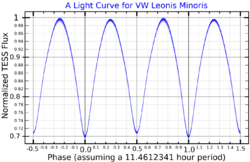Astronomy:VW Leonis Minoris
| Observation data Equinox J2000.0]] (ICRS) | |
|---|---|
| Constellation | Leo Minor |
| Right ascension | 11h 02m 51.910s[2] |
| Declination | 30° 24′ 54.70″[2] |
| Apparent magnitude (V) | 8.07[3] |
| Characteristics | |
| Spectral type | F2V + G2V[4] |
| B−V color index | +0.410±0.015[3] |
| Variable type | Suspected W UMa[5] |
| Astrometry | |
| Radial velocity (Rv) | +5.00±0.75[3] km/s |
| Proper motion (μ) | RA: +12.304[2] mas/yr Dec.: −4.764[2] mas/yr |
| Parallax (π) | 8.8238 ± 0.1046[2] mas |
| Distance | 370 ± 4 ly (113 ± 1 pc) |
| Absolute magnitude (MV) | 2.46[3] |
| Orbit – Contact (1 & 2)[6] | |
| Period (P) | 11.461225 h |
| Eccentricity (e) | 0.0 |
| Semi-amplitude (K1) (primary) | 105.8±1.0 km/s |
| Semi-amplitude (K2) (secondary) | 250.2±1.2 km/s |
| Orbit – Non-contact (3 & 4)[6] | |
| Period (P) | 7.93063 d |
| Eccentricity (e) | 0.035±0.003 |
| Periastron epoch (T) | 2,452,274.54±0.11 HJD |
| Argument of periastron (ω) (secondary) | 1.90±0.09° |
| Semi-amplitude (K1) (primary) | 63.99±0.23 km/s |
| Semi-amplitude (K2) (secondary) | 65.53±0.27 km/s |
| Orbit – Mutual (12 & 34)[6] | |
| Period (P) | 355.02±0.17 d |
| Eccentricity (e) | 0.097±0.011 |
| Periastron epoch (T) | 2,453,046±6 HJD |
| Argument of periastron (ω) (secondary) | 2.20±0.12° |
| Semi-amplitude (K1) (primary) | 21.61±0.49 km/s |
| Semi-amplitude (K2) (secondary) | 23.22±0.33 km/s |
| Details | |
| Component 1 | |
| Mass | 1.68±0.02[7] M☉ |
| Radius | 1.69±0.02[7] R☉ |
| Luminosity | 8.73[3] L☉ |
| Surface gravity (log g) | 4.21±0.02[7] cgs |
| Component 2 | |
| Mass | 0.71±0.02[7] M☉ |
| Radius | 1.18±0.02[7] R☉ |
| Surface gravity (log g) | 4.14±0.02[7] cgs |
| Other designations | |
| Database references | |
| SIMBAD | data |
VW Leo Minoris is a tight quadruple[6] star system, located in the constellation of Leo Minor. With a peak combined apparent visual magnitude of 8.07,[3] it is too faint to be seen with the naked eye. Parallax measurements give a distance estimate of approximately 370 light years from the Sun, and it is drifting further away with a radial velocity of +5 km/s.[3]
| Component 1 | |||||||||||
| Period = 0.48 d | |||||||||||
| Component 2 | |||||||||||
| Period = 355.02 d | |||||||||||
| Component 3 | |||||||||||
| Period = 7.93 d | |||||||||||
| Component 4 | |||||||||||
Hierarchy of orbits
This system was found to be variable using observations with the Hipparcos satellite. It is classified as an A-type[7] W Ursae Majoris eclipsing binary, where the two stars share a common envelope. The eclipse of the primary causes the magnitude of the system to drop to 8.45.[5] These components (1 & 2) have an orbital period of 11.4611 hours and the orbital plane has an inclination of 72.4° to the line of sight from the Earth.[6] They have a combined stellar classification of F2V, matching an F-type main sequence star.[4]
In 2006 an additional, detached binary component was discovered, making this a quadruple star system.[9] This binary has an orbital period of 7.93 days, a mild eccentricity (ovalness) of 0.04,[6] and it shows an apsidal precession with a period of 78.6±1.6 years.[4] The components (3 & 4) have a combined stellar class of G2V,[4] showing a match with a G-type main-sequence star.[4]
The two binaries (1–2 & 3–4) orbit each other with a period of 355 days and an eccentricity of 0.1.[6] The plane of their orbit is close to coplanar (within 5°) with the orbital plane of the detached binary. This outer orbit appears stable, suggesting there is no additional outlying component to this system.[4] The nearby ninth magnitude star HD 95606 (HIP 53969) shares a common proper motion with this system and may be loosely gravitationally bound. They likely all formed in the same protostellar cloud.[6]
References
- ↑ "MAST: Barbara A. Mikulski Archive for Space Telescopes". Space Telescope Science Institute. https://mast.stsci.edu/portal/Mashup/Clients/Mast/Portal.html.
- ↑ 2.0 2.1 2.2 2.3 Brown, A. G. A. (2021). "Gaia Early Data Release 3: Summary of the contents and survey properties". Astronomy & Astrophysics 649: A1. doi:10.1051/0004-6361/202039657. Bibcode: 2021A&A...649A...1G. Gaia EDR3 record for this source at VizieR.
- ↑ 3.0 3.1 3.2 3.3 3.4 3.5 3.6 Anderson, E.; Francis, Ch. (2012), "XHIP: An extended hipparcos compilation", Astronomy Letters 38 (5): 331, doi:10.1134/S1063773712050015, Bibcode: 2012AstL...38..331A.
- ↑ 4.0 4.1 4.2 4.3 4.4 4.5 Pribulla, T. et al. (May 2020), "Secular changes in the orbits of the quadruple system VW LMi", Monthly Notices of the Royal Astronomical Society 494 (1): 178–189, doi:10.1093/mnras/staa699, Bibcode: 2020MNRAS.494..178P.
- ↑ 5.0 5.1 Samus, N. N. et al. (2017), "General Catalogue of Variable Stars", Astronomy Reports, 5.1 61 (1): 80–88, doi:10.1134/S1063772917010085, Bibcode: 2017ARep...61...80S.
- ↑ 6.0 6.1 6.2 6.3 6.4 6.5 6.6 6.7 Pribulla, T. et al. (October 2008), "VW LMi: tightest quadruple system known. Light-time effect and possible secular changes of orbits", Monthly Notices of the Royal Astronomical Society 390 (2): 798–806, doi:10.1111/j.1365-2966.2008.13781.x, Bibcode: 2008MNRAS.390..798P.
- ↑ 7.0 7.1 7.2 7.3 7.4 7.5 7.6 Djurašević, G. et al. (March 2013), "Photometric Analysis of HS Aqr, EG Cep, VW LMi, and du Boo", The Astronomical Journal 145 (3): 10, doi:10.1088/0004-6256/145/3/80, 80, Bibcode: 2013AJ....145...80D.
- ↑ "VW LMi". SIMBAD. Centre de données astronomiques de Strasbourg. http://simbad.u-strasbg.fr/simbad/sim-basic?Ident=VW+LMi.
- ↑ Pribulla, Theodor; Rucinski, Slavek M. (June 2006), "Contact Binaries with Additional Components. I. The Extant Data", The Astronomical Journal 131 (6): 2986–3007, doi:10.1086/503871, Bibcode: 2006AJ....131.2986P.
 |


